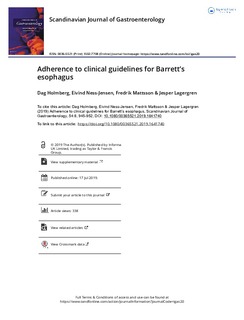| dc.contributor.author | Holmberg, Dag | |
| dc.contributor.author | Ness-Jensen, Eivind | |
| dc.contributor.author | Mattsson, Fredrik | |
| dc.contributor.author | Lagergren, Jesper | |
| dc.date.accessioned | 2019-09-30T06:09:27Z | |
| dc.date.available | 2019-09-30T06:09:27Z | |
| dc.date.created | 2019-09-28T18:07:16Z | |
| dc.date.issued | 2019 | |
| dc.identifier.citation | Scandinavian Journal of Gastroenterology. 2019, 54 (8), 945-952. | nb_NO |
| dc.identifier.issn | 0036-5521 | |
| dc.identifier.uri | http://hdl.handle.net/11250/2619256 | |
| dc.description.abstract | Background and aim: Clinical guidelines recommend endoscopy surveillance at given intervals or endoscopic therapy for Barrett’s esophagus with low-grade dysplasia (LGD) and high-grade dysplasia (HGD). Whether these guidelines are followed in clinical practice is unknown and was assessed in this study.
Methods: This nationwide Swedish cohort study included patients with Barrett’s esophagus with histologically verified LGD or HGD from 50 centers in 2006–2013. These patients were followed up using nationwide registers. Adherence to clinical guidelines was explored. Eight potential risk factors for deviation from guidelines were assessed using multivariable logistic regression, providing adjusted odds ratios (OR) with 95% confidence intervals (95%CI).
Results: Among 211 patients with Barrett’s esophagus (mean age 67.0 years, standard deviation 9.7 years, 81% male), 71% had LGD and 29% had HGD. During median 3.9 years of follow-up, 84% underwent a follow-up endoscopy, 17% received endoscopic therapy and 8% underwent esophagectomy. The clinical management deviated from guidelines in 60% of all patients (69% in LGD and 39% in HGD), which was mainly due to under-surveillance (86%). Risk factors for deviation from guidelines were LGD compared to HGD (OR 3.4, 95%CI 1.7–6.8), longer Barrett’s segment length (OR 2.0, 95%CI 1.0–3.9, comparing ≥3 cm with <3 cm), and treatment at gastroenterology compared to surgery departments (OR 2.3, 95%CI 1.2–4.4). Age, sex, calendar period and university hospital status were not associated with deviation from surveillance guidelines.
Conclusions: Adherence to guidelines for dysplastic Barrett’s esophagus is poor, particularly for LGD. Efforts to implement clinical guideline recommendations are needed. | nb_NO |
| dc.language.iso | eng | nb_NO |
| dc.publisher | Taylor & Francis | nb_NO |
| dc.rights | Navngivelse 4.0 Internasjonal | * |
| dc.rights.uri | http://creativecommons.org/licenses/by/4.0/deed.no | * |
| dc.title | Adherence to clinical guidelines for Barrett’s esophagus | nb_NO |
| dc.type | Journal article | nb_NO |
| dc.type | Peer reviewed | nb_NO |
| dc.description.version | publishedVersion | nb_NO |
| dc.source.pagenumber | 945-952 | nb_NO |
| dc.source.volume | 54 | nb_NO |
| dc.source.journal | Scandinavian Journal of Gastroenterology | nb_NO |
| dc.source.issue | 8 | nb_NO |
| dc.identifier.doi | 10.1080/00365521.2019.1641740 | |
| dc.identifier.cristin | 1730646 | |
| dc.description.localcode | © 2019 The Author(s). Published by Informa UK Limited, trading as Taylor & Francis Group. This is an Open Access article distributed under the terms of the Creative Commons Attribution License (http://creativecommons.org/licenses/by/4.0/), which permits unrestricted use, distribution, and reproduction in any medium, provided the original work is properly cited. | nb_NO |
| cristin.unitcode | 194,65,20,15 | |
| cristin.unitname | Helseundersøkelsen i Nord-Trøndelag | |
| cristin.ispublished | true | |
| cristin.fulltext | original | |
| cristin.qualitycode | 1 | |

